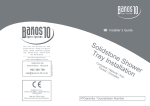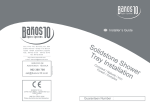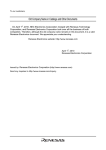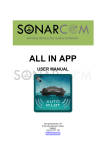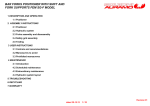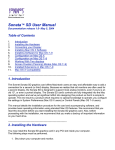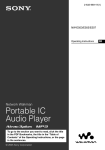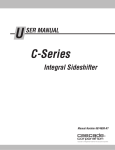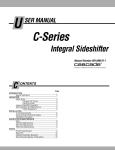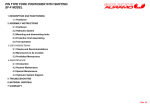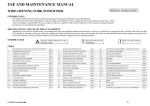Download Manual Hook on _ohne Garantieerkl_
Transcript
Service manual hook on fork positioner Rel.1.3 del 01/01/2010 Pag.1/16 Summary Page 1. Introduction 3 2. Description and functioning 4 3. Assembling instructions 5 3.1 Mounting hook on ISO plate 5 3.2 Mounting hooks on ISO plate 6 3.3 Hydraulic installation 7 Instructions for use 9 4.1 Checks and suggestions 9 4.2 Driving operations to be avoided 9 4.3 Driving operations not allowed 9 Service and Maintenance 10 5.1 Introduction 10 5.2 Periodic or ordinary maintenance 10 5.3 Extraordinary maintenance 11 6. Breakings and solutions 15 7. Disposal 16 4. 5. Rel.1.3 del 01/01/2010 Pag.2/16 1.Introduction This Manual includes instructions for: assembling, maintenance (periodic and extraordinary), possible damages with solution. The instructions in this manual do not substitute but integrate the obligation to respect the present law regarding the safety and anti- industrial accidents regulation, that are under responsibility of the User-Company. The User Company is also obliged to point out all instructions present in this Manual, included the staff’s training for the correct use of the Attachment and for its maintenance. Forklift Attachment, suitable for the positioning of load forks during pallets-movement that have different dimensions. It is composed by a bar-chassis with lower ISO Profile. The forks positioning, according to the pallets openings, must be done before the clamping of the load. Each Attachment is introduced in the market on pallets which have standard dimension (800x1200 mm) with two fixing polyester belts end with a thermorestricting cover. Situation of danger possibility for safety’s driver Adhesive labels anti-accident Adhesive Label Rel.1.3 del 01/01/2010 Pag.3/16 2.Description and functioning Device for positioning the load forks (Pic.1) in a synchronized way Such device is formed by a chassis in the upper side there is a bar used like guide’s and load’s support, moved by the forks. The load forks, supplied by us, have in the upper side guide bushings and wiper rings, they are moved by double effect front cylinders and in the lower side we have sliding rollers with greasers. The “STANDARD” hydraulic installation has flow divider 50/50 and entrance with metric threaded pipe-fittings and cutting ring DIN 3861-B diameter 8 mm. Herebelow the layout of the adhesive label (Pic.2) and the layout of the anti-accidents adhesive label. (Pic.3). Load Fork (Pic.1) Chassis Bar Label anti-accidents label Upper hook Cylinder Lower hook Anchorage Rollers (Pic.2) (Pic.3) Rel.1.3 del 01/01/2010 Pag.4/16 3. Assembling instruction 3.1 Mounting hooks on ISO plate - Unscrew the left hook HL (Pic.4) and the right hook HR (Pic.5) Lift the fork positioner from point A (Pic.4) Centre the lock B (Pic.4) on lift truck’s mounting plate C (Pic.5) Tighten the bolts M14 of the left hook HL and the right hook HR (Pic.4) to 135 Nm (100 Ft-Lbs). (Pic.4) A B HL (Pic.5) HR C Attention: Check the exact matching between hooks and lift truck plate. C Rel.1.3 del 01/01/2010 Pag.5/16 3. Assembling instruction 3.2 Mounting hooks on ISO plate 3.2.1 Remove the four bolts with 10 mm spanner (Pic.6 DM1), insert the ISO forks in the support profile (Pic.6 DM2), tighten again the bolts with the washers (Pic.6 DM1) to a couple of 85 Nm, (63 Ft-Lbs) 3.2.2 Tighten he bolts with 18 mm spanner and the nuts with a 6 mm screw socket (Pic.6 DM3 DM4) until the bolts will be tighten on the fork. 3.2.3 Tighten the nuts on the bolts (Pic.6 DM3 DM4) to a couple of 50 Nm (37 Ft-Lbs). (Pic.6) ATTENTION: Verify that all nuts and bolts will be tighten correctly. Rel.1.3 del 01/01/2010 Pag.6/16 3. Assembling instruction 3.3 Forks assembling with ISO rollers hooks 3.3.1.Remove the two bolts wth 5 mm screw (pic.7 DM1), remove the pin diameter 10 (pic.7 DM2), insert the forks ISO into hook’s profile (Pic.7. DM3), insert the pin diameter 10 (Pic.7 DM2), tighten again the bolts (Pic. 7 DM1) to a couple of 42 Nm, (31 Ft-Lbs) 3.3.2 Tighten the bolts with screw of 18 mm and the nuts with special spanner of 6 mm (Pic.7 DM4 DM5) till the fork is bolted. 3.3.3 Tighten the nuts on the bolts (Pic.7 DM4 DM5) to a couple of 50 Nm (37 Ft-Lbs) (Pic.7) ATTENTION: Verify that all nuts and bolts will be tighten correctly. Rel.1.3 del 01/01/2010 Pag.7/16 3.Assembling Instruction 3.4 Hydraulic Installation 3.4.1 Connect, with flexible tubes complete with terminal pipe-fittings diameter 8 with nut 14x1.5 mm, the installation located on the Lift-Truck’s mast to the pipe-fittings: “open” for opening “close” for closing” “SL” for left sideshifting “SR” for right sideshifting As indicated in picture n.6/6a, tightening the nuts with couple of 60 Nm (43 Ft-Lbs). 3.4.2 Do some testing movements in order to verify the perfect hydraulic keeping of pipe-fittings, the speed and the synchronism of forks movement. In case of oil’s leaks demount the involved fittings and clean it carefully. Forks speed and synchronism are checked automatically by a flow divider put on the aluminium valve. (Pic.8) (Pic.9) Front view of Hydraulic Installation References left – right Lift Truck’s driver’s side Attention: Connect the pipes as per attached hydraulic scheme. Attention: Do some testing movement before starting. Rel.1.3 del 01/01/2010 Pag.8/16 4.Instructions for use 4.1 Checks and suggestions - Fork the load in the most possible central position Keep the load in a few lifted position in order to have a bigger Lift Truck’s stability during the movements. Keep the load with lifted fork’s tips during the lift truck’s movement. Move the control levers in a soft way in order to avoid sudden pressure changes in the hydraulic installation and consequently compromise the load stability. - Adapt the Lift truck’s speed according to the type of load and according to the difficulties about space - Pay attention to the floor’s steep, or to its inclination as both situation can affect the load’s stability. - Before moving the pallet adjust the fork’s position in order not to force them against the base of the pallet. 4.2 Movements to be avoided (D-E-F-G Pic.10) - To move bigger loads than the nominal capacity. To move not stable loads To move the load with only one fork, even if the weight is not so much. To move a side load using the load which is already on the forks. To effect very quickly movements of lift truck with the load on forks in high position To effect sideshifting stroke or forks positioning with the load on forks e lift truck on movement. 4.3 Movements not allowed - To use the attachment for different purposes than those ones for which it has been built. To move the movements control lever when the attachment is under maintenance To drive the lift truck during bad visibility conditions due to a too big load To tamper with the attachment. To stop in the action area of the attachment. (Pic.11) To use the attachment when it presents a deformation, even minimal, of its structure or in any case problem in its functioning. - It is not a clamp (do not use the forks to block the load either in opening or in closing (Pic.10 D-E-FG) (Pic.10) (Pic.11) Danger Area Rel.1.3 del 01/01/2010 Pag.9/16 5.Maintenance 5.1 Introduction The attachment is delivered with the guides greased with high quality grease in order to warranty normal adjustment and polishing of the rubbing surfaces during the first period of using. The recommended grease is ISO X M2 (SHELL ALVANIA GREASE R2 or correspondent type) Using the attachment in very dusty environment, we suggest to use the oil ISO CB 32 (ESSO NUTO 32 or correspondent type) The below indicated maintenance is connected to a correct use of the attachment in a clean and very few dusty environment. 5.2 Periodic or ordinary maintenance 5.2.1 Maintenance every 500 hours - Grease in area “g.1” (Pic.13) e (Pic.14). - Checking screws’ tightening in points “s.1”, in case of screws’ working loose, for Types ISO 2 e ISO 3 35 Tons tighten them with couple 89 Nm (65 Ft-Lbs) and for types ISO3 49 Q.li with couple 135 Nm (100 Ft-Lbs) for types ISO 3 49 q.li; In case of substitution or demounting of the above mentioned screws mount them again with the relative washers in the appropriate way, as showed in the picture and on adhesive label on attachment. Attention: After 5 re-utilizations the washers NORD-LOCK (Pic.12) have to be changed with new ones. - Check the screw tightening of the chromium-plate bar’s lock. Point “s.2” (in case of screw’s working loose, clean the screw and tighten it again using “Loctite 243”. - Check hydraulic fittings - Check general condition of the attachment 5.2.2 Maintenance every 1000 hours : (Pic.12) In addition to what as been indicated in point 5.2.1 do: - Cleaning of roller’s slide guides - Check of general condition of the attachment - Specific checking of pipes condition (Pic.13) g.1 (Pic.14) s.1 g.1 g.1 s.2 g.1 g.1 g.1 s.1 Rel.1.3 del 01/01/2010 Pag.10/16 5.Maintenance 5.3 Extraordinary maintenance Introduction operation - Before starting any special maintenance, switch off the Lift Truck and take off the pressure in the supply circuit. - Be sure that during all maintenance period the pump has not to be put on function and the lever’s distributor has not to be put in action. 5.3.1 Cylinder demounting and fork’s moving (for attachments with capacity 2,5 e 3,5 t) (Pic.15) - Take off the elastic ring pos. “sm1” using a screwdriver - Take out the pin pos. “sm2” with punch diam. 8 mm - Unscrew the two bolts pos. “sm3” (Pic.15) Sm.2 Sm.1 Sm.3 Rel.1.3 del 01/01/2010 Pag.11/16 5.Maintenance 5.3.2 Substitution of cylinder’s seals (Pic.16) - Unscrew the plug “cs05”, with the appropriate tool, and take it out from the rod - Take out the rod “cs02” from cylinder’s case - Proceed with the seals’ substitution “cs01”, “cs03”, “cs04”, “cs06”, “cs07” e “re03” (wherever is necessary use screwdriver) The cylinder’s remounting must be done in the opposite way than the above described one, using particular attention to the cleaning and checking the exact position of the seals “cs06” e “cs07” (Dett.cp) (Pic.16) Rel.1.3 del 01/01/2010 Pag.12/16 5.Maintenance 5.3.3 Scheme of Hydraulic Installation (Pic.17/18) (Pic.17) (Pic.18) Front View of Hydraulic Installation Please refer left-right driver’s side of the Lift Truck NB: The Lift-Truck Manufacturer will give instruction about the distributor to use. NB: For eventual breaking concerning the Fork Positioner, please check point 6 “BREAKINGS AND SOLUTIONS ” of this Manual. Rel.1.3 del 01/01/2010 Pag.13/16 5.Maintenance 5.3.4 Substitution of Seal’s Valve (Pic.19/20) - gv.1 Unscrew the flow divider “gv1” (Fig.19/20) Unscrew the cartridge “gv2” (Fig.19) Unscrew the cartridge “gv3” (Fig.19) Proceed with the seals’ substitution “g1”, “g2”, “g3” (Fig.19/20) Remount the cartridges tighten 45 Nm (33 Ft-Lbs) (Fig.19) Remount the flow divider tighten a 60 Nm (44 Ft-Lbs) (Fig.19/20) gv.2 (Pic.19) G1 G2 (Pic.20) gv.1 G1 G3 gv.3 Rel.1.3 del 01/01/2010 Pag.14/16 6.Breakings and solution Breakings 6.1 there is no fork’s movement 6.2 Forks’ movement is too low 6.3 There is no synchronised movement of the forks Reasons Obstacles or too much amassed dirty on slide-bars Not enough hydraulic pressure Obstruction or breakings in the hydraulic installation Internal cylinder’s leaking (wear and tear seals ) Not enough oil’s capacity Obstructions in the Hydraulic Installation Internal Cylinder’s leaking (wear and tear seals ) Obstacles or too much amassed dirty on slide –bars Seals wear and tear on flow divider Solution Remove the obstacles , clean and grease the slide-bars Checking and adjustement of the supplied pressure of the Lift Truck pump. Eliminate the obstruction or substitute the damaged pipe Checking and eventual substitution of the seals check point “5.3.2” Checking and adjustement of the supplied capacity by the lift truck pump. Eliminate the obstruction or substitution of the damaged tube Checking and eventual substitution of the seals–check point “5.3.2” Remove the obstacles, clean and grease the slide-bars Checking and eventual substitution of the seals see point “5.3.4” Note: Whenever there are difficulties concerning a correct intervention, or the defect is different or missing from those ones described above, we please you to contact the technical service assistance. Rel.1.3 del 01/01/2010 Pag.15/16 7.Disposal If we want to get rid f the attachment we suggest to divide and collect separately all recycle materials. Parts Chassis, cylinders and forks Lower hooks Pads Paint Fixing belts Bushings Hydraulic oil Pallet Housing Cylinder seals Materials Steel Cast Iron Nylon / bronze Paint Polyester Bronze According to local laws Wood Polyester / Steel Poliuretan and NBR Attention: not recycle Materials or in any case those ones that may be a danger for the environment (Oil, Gum, Plastic, etc) must be disposal according to the local directives Rel.1.3 del 01/01/2010 Pag.16/16
















